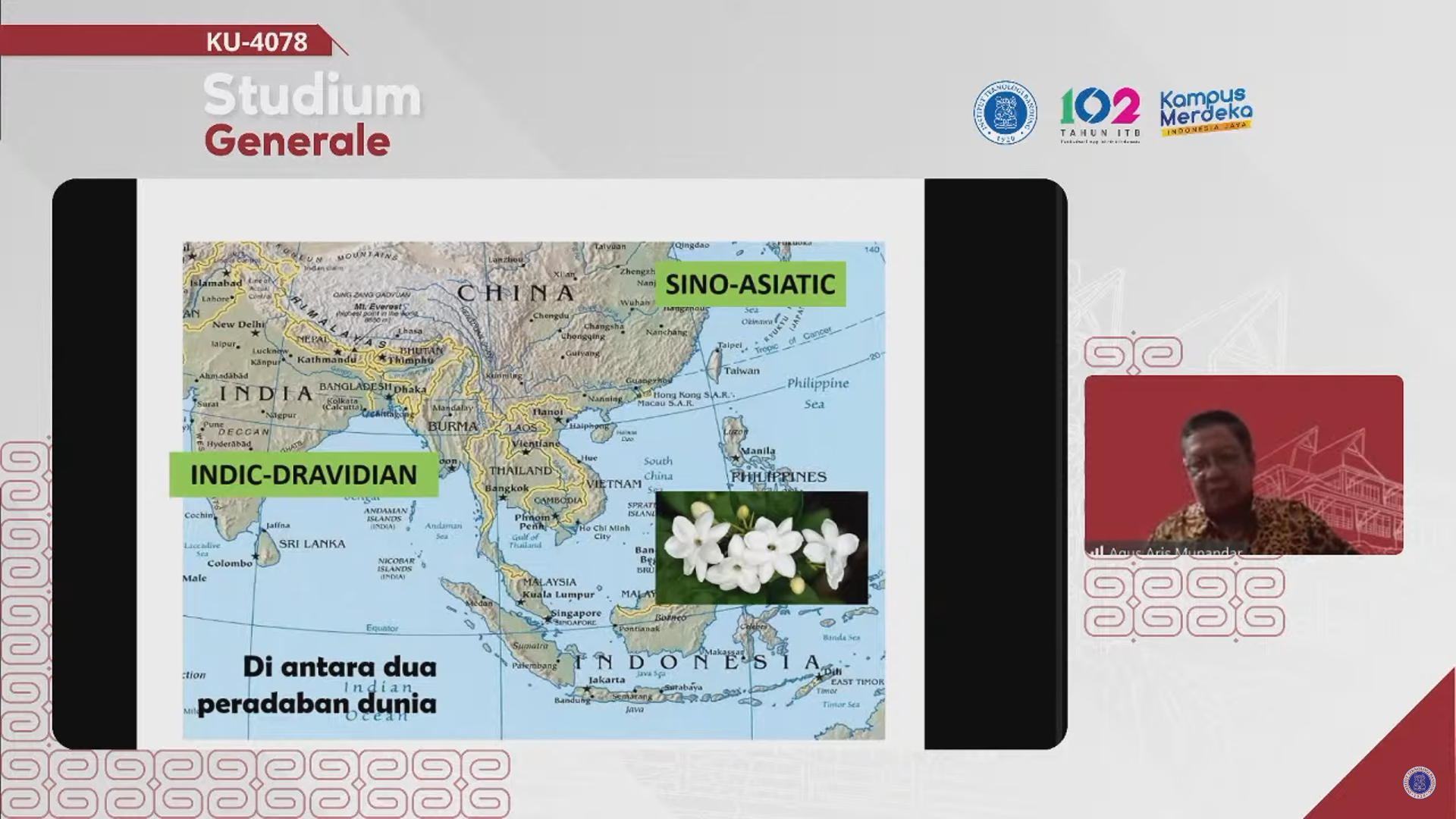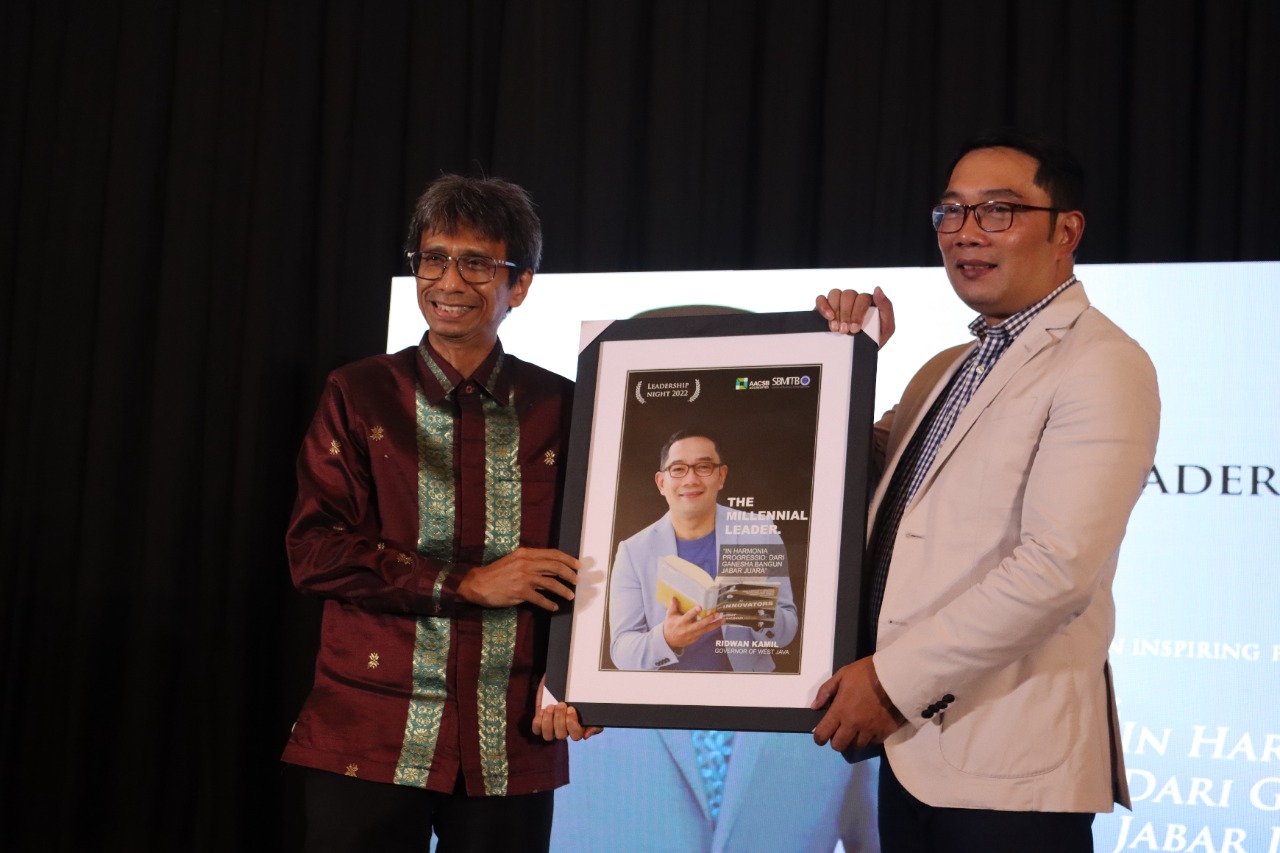ITB Studium Generale: Studying Indonesia's Glory During the Hindu-Buddhist Classical Era
By Adi Permana
Editor Adi Permana

BANDUNG, itb.ac.id – Today’s development of Indonesia’s civilization is inseparable from past events that connect with each other. Nonetheless, there is always wisdom that can be drawn from these histories.
The KU4078 Studium General course on Wednesday (11/16/22) discussed the history of Indonesia. Titled "The Rise of Indonesia’s Glory”, the topic was delivered by the archaeologist Prof. Dr. Agus Aris Munandar, M. Hum.
"Indonesia’s ethnic diversity is unparalleled. According to H. Th. Fischer, this diversity is caused by the ethnic differences that existed long ago, Prof. Agus began his presentation. “It is also caused by the migration of these people. They rarely interact with one another after migrating, giving rise to different ethnic groups.”
This assumption is evidenced by protohistoric records that reveals the fact that the people of Southeast Asia, including Indonesia, has skills in the following field: doll-making, ornamental design, metal casting, trading, playing musical instruments, astronomy, navigation and voyage, oral communication, irrigation, and community order.
One of the famous cultural distributions is the Dong-Son culture originating from Vietnam. This culture carries important bronze objects, especially the nekara. The nekara visualizes historical value thick with features; its upper surface is depicted with illustrations of a bright sun surrounded by four frogs. Indonesia itself has the largest nekara, commonly known as the Moko nekara.
In the past, Indonesia was located between the two major global and advanced civilizations- India and China. Both had a significant influence in the progress of Indonesia’s civilization. Indonesians were interested in the culture introduced by India and adopted their scriptures, religion, and saka year.

Simply from the introduction of these three aspects, the Indonesia that we are familiar with from its royal ages to the modern era began. Prof. Agus summarized the reigning period of the Indonesian kingdom as the 'Dawn of Civilization' with three stages: the early, old, and young periods.
Early and Old Classical Periods of Kingdoms (5th - 8th Century AD)
Some kingdoms that were established during the early classical period were Tarumanagara and Kutai Kuno. On the other hand, the kingdom of Srivijaya, Kanjuruhan, and Mataram began in the old classical period.
1. Tarumanagara Kingdom
The Tarumanagara kingdom was located on Western Java that stretches from Banten to Bekasi. One of its famous relics is the Ciaruteun tablet which displays the soles of King Purnawarman. It also contains writings that prove the existence of this kingdom. Another historical relic left by the Tarumanagara kingdom is the Muara Cianten tablet which is yet to be interpreted. Moreover, remains of the Batujaya temple in North Karawang indicate the once-ruling kingdom, with its style of Mahayana Buddhism found in its two shrines Blandongan and Jiwa.

2. Kutai Kuno Kingdom
The location of the Kutai kingdom is on the banks of East Kalimantan’s inland river. The kingdom left a yupa tablet filled with messages that are successfully interpreted. Other relics such as the hindu-trimurti statues are found at the mountain caves of Kombeng, Kutai.
3. Sriwijaya Kingdom
The Sriwijaya region encompasses Western Indonesia to Malaysia. Evidence of its existence is marked by illustrations of the Srivijaya-Java sails on the Borobudur temple. The Srivijaya kingdom also left several temples, including the Tinggi temple that is said to be the center of Buddhism with 1,000 monks. Other relics such as tablets and bronze statues are found as well.
4. Kanjuruhan Kingdom
The Kanjuruhan kingdom is mentioned in the Dinoyo tablet dating back to 760 AD, with information about the kingdom’s ruler Liswa/Gajayana and his royal family. Other relics of this kingdom are the Badut temple and the Durga Mahisasuramardini statue.
5. Mataram Kingdom
The Mataram kingdom left the largest temple in the world known as the Borobudur temple. This kingdom rose to power in Central Java in the 8th - 10th Century AD. Thanks to its grandeur, the kingdom has many monumental buildings in the form of temples and shrines. The relics of the temples include the Merak temple, Bubrah temple, Gedong Songo temple, Sivagrha (Prambanan) temple, and the temple built in the Dieng plateau.
Young Classical Periods of Kingdom
1. Kadiri/Kediri Kingdom
The first king of the Kadiri kingdom was Sri Maeswara Sakalabhuwanatustikarana Sarwwani-waryyawiryya Parakrama Digjayottunggadewa (1,117-1,130 AD). The last king was named Srengga-Krtajaya, who was defeated by Ken Arok and created the Singhasari kingdom. The Kadiri kingdom left behind several statues, temples, literature, and fine arts. Notable literary works that came out from this kingdom include Arjunawiwaha, Bhratayuddha, Gatotkacasraya, and more.
2. Singhasari Kingdom
Established in the thirteenth century, the Singhasari kingdom is located in East Java. One of its historical relics is the Jawi temple, known for its Shiva-Buddhist patterns (inspired by Buddha Mahayana and Hindu Siwa) that incorporates the architectural style of Shiva at its lower parts and Buddha at the top. This style is unique due to the two inspirations having conflicting perspectives in India. The Singhasari kingdom was the first to introduce the concept of Nusantara and Dwipantara which means "Islands outside Java''.
3. Malayu Dharmmasraya Kingdom
The Malayu Dharmmasraya kingdom that stood in the 14th century was mentioned in Mpu Prapanca's work (Nagarakrtagama) in Sumatra. The king, Adityawarman, had made several tablets such as the Kapolo Bukit Gombak I, Bukti Gombak II, and Suroaso I. Other historical relics were the Padang Roco I and II temples.
4. Kuna Kingdom
The Kuna Kingdom from Bali first appeared in the 9th century. Its center of operation was at Kedaton Singhamandawa. Statue remnants of this kingdom are unique for its sculpted cliffs. Another relic found is the lake in Manukraya village that is now developed into the Tirtha Empul temple in Gianyar.
5. Majapahit Kingdom
The Majapahit kingdom was the last kingdom of the classical (Hindu-Buddhist) era, in which its historical evidence is widely found in Trowulan. Prof. Agus once sketched the center of Majapahit city, complete with the Keraton palace, residential area, throne, marketplace, and shrines. Some of the famous temples are the Jago, Brahu, Jawi, and Angka Tahun Panataran.
For the Majapahit era, the author Mpu Prapanca introduced the term “Uttama-Madya-Nista” to describe the regional distribution. Uttama is the area of Majapahit kingdom that covers the Indonesia archipelago. The Madya area includes the neighboring Desantara and Mitreka Satata kingdoms in Southeast Asia. Lastly, the Nista region has Anyadesa which indicates the area outside the kingdom. During those days, other regions like Europe and America were not imagined by the people yet.
With the end of the Majapahit kingdom, the classical era in Indonesia comes to a closure. The classical age is considered as the start of Indonesia’s many achievements in its civilization. During the protohistory period, the people had only received three cultures based from India, namely the script (Pallava), Saka year, and Hindu-Buddhist religion. From these three, Indonesia managed to give rise to its prosperous years through royalty, architecture, fine arts, and more.
Reporter: Lukman Ali (Mechanical Engineering, 2020)
Translator: Ruth Nathania (Environmental Engineering, 2019)

.jpg)
.png)
.jpg)
.jpg)
.jpg)



